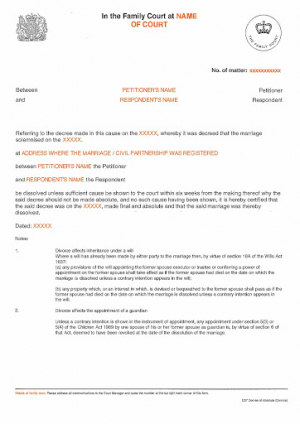What is a decree absolute? Step-by-step guide
A decree absolute or form D36 is the final stage of a divorce process. If you’re thinking about how this works then you will soon be officially divorced – divorce can be an emotional, exhausting journey, but you’re almost there.
What is a decree absolute?
A decree absolute is what the new final order certificate used to be called. When you receive your decree absolute it means that you are legally divorced or that your civil partnership has been dissolved. You are only able to apply for your decree absolute six weeks and one day after your conditional order date (previously called the decree nisi).
No-fault divorce was introduced on the 6th of April 2022 and as part of the changes, the language used on the forms was updated. Under the new system, the decree absolute is called the final order, and the decree nisi is called the conditional order. If you're on the previous journey, your application and certificate will still be called the decree absolute.
In this blog, we are looking at the previous system and terminology, before the introduction of no-fault divorce. If you applied for your divorce after the 6th of April 2022, you can read our guide on applying for your final order.
How to apply for a decree absolute: step-by-step
You can apply for your divorce or dissolution online or via post.There are four steps you’ll need to complete to get a decree absolute, we have outlined them below:
Step one: The divorce or dissolution petition (the legal form is called ‘D8’)
To start the legal process of ending your marriage or civil partnership, you will need to submit a divorce or dissolution petition to the court. Read our step-by-step guide on how to do this.
Step two: The acknowledgement of service (the legal form is called ‘D10’)
When the courts receive your petition – which is now called the divorce application – and court fee (you may be entitled to a discount on the £612 court fee), your ex-partner will receive a document through the post. If you’ve applied online, then they will receive a letter with login details so that they can acknowledge that they have received the petition online. If you have posted your divorce petition to court, they will need to fill in the form sent to them and return it to the court.
Step three: decree nisi stage (the legal forms are called ‘D84’ and ‘D80’)
Decree nisi is the stage where a judge will review your petition and decide if they agree that the marriage/civil partnership has broken down past the point of repair. Read more about how to apply for your decree nisi application.
If the judge approves the petition, you will receive a letter stating your ‘decree nisi pronouncement date’.
Your decree nisi pronouncement date allows you to proceed with the following:
- If you have finances to sort out, you can submit your consent order to the court for a judge to review. A consent order is a legally binding document that formalises your financial split and stops the possibility of future claims.
- The countdown for when you can apply for your decree absolute or final order starts on your decree nisi pronouncement date. Couples must wait six weeks and one day after this date before they can submit their application for the decree absolute. See this as a cooling-off period – it’s your last chance to reconsider.
Step four: decree absolute (the legal form is called ‘D36’)
Once you have waited six weeks and one day after your decree pronouncement date you can apply for the decree absolute. If you've applied for your divorce by post, it usually takes the courts around two weeks to send you the decree absolute certificate. If you have applied for your divorce online it will take one to two days, subject to court processing times.
A decree absolute is an official document issued by the court, confirming the dissolution of your marriage or civil partnership. While the appearance of decree absolute certificates may vary slightly, they always include key details such as your name, case number and the date the order was finalised.
If you need more information on any of the above process, read our full guide on how to apply for divorce in England or Wales.
How to fill in the decree absolute form
If you have applied for your divorce by post, then the below steps will help you fill out your decree absolute. The decree absolute application form, also called the D36 form, is the most straightforward in the divorce process. You will need to fill in all the details, including:
- The name of the court that you’re processing your divorce/dissolution through.You can find details of this on your other paperwork, for example, your decree nisi paperwork.
- The case number. This can be found on your other paperwork too
- Name of the petitioner, which means the person who started the divorce process
- Name of the respondent or the other person
- Name of the co-respondent. This is only relevant if you’ve used adultery as the reason for divorce and have chosen to name the other person
- You’ll then need to indicate if the petitioner or respondent is applying for the decree absolute
- The ‘decree nisi’ refers to your decree nisi pronouncement date – you can find this on your decree nisi certificate
- Make sure the document is signed and that the date is at least six weeks and one day after the decree nisi pronouncement date
Want to know more about the divorce process?
How do you get a copy of the decree absolute form?
If you applied for your divorce online, then you will receive an email when you can apply for your decree absolute. If you applied via post, then you can download a copy of the decree absolute form below:
Download the D36 form.
What does the decree absolute certificate look like?
If you have applied for your divorce online, then the decree absolute certificate will look slightly different to the paper example below:

How much does a decree absolute cost and how to get a copy?
This depends how you manage the entire process. For more information on the different ways to divorce and how much they cost, see our article on the cost of divorce.
If you’ve lost your decree absolute certificate and need a new one, you can either contact the courts or ask whoever managed your divorce/dissolution for a new copy. You may need to pay a small administrative fee to get a new copy.
The divorce process above usually takes around four months to complete if you aren't applying for a financial remedy order, also known as a consent order. If you’re unsure about any of the above, get in touch, as one of our experts will be happy to talk you through the process.
Navigate separation with supportive guidance
If you’re ready to take the first step towards an amicable separation, we’re here to help. Navigate your separation in a kinder way, while achieving fair, balanced agreements and a positive future apart. Our Specialists manage the entire court process on your behalf, so you can focus on what matters.
Get in touch to learn how we can help you and your ex-partner.
Decree Absolute FAQs
What does decree absolute mean?
This is the final part of the divorce process. Once you receive your decree absolute certificate from the court, your divorce is complete.
How does decree absolute work?
You will need to apply for your decree absolute certificate after the six weeks and one day cooling-off period from your decree nisi pronouncement date.
What is the difference between decree nisi and decree absolute?
The decree nisi is the middle stage of the divorce process, where the judge reviews your petition and decides whether you're entitled to a divorce. The decree absolute is the final stage of the divorce process, where the court completes your divorce. You need a copy of your decree absolute certificate in order to prove that you are divorced.
What are the risks of applying for a decree absolute too soon?
If you finalise the divorce before the cooling-off period is complete, the court might reject your application. You also need to consider if you want to have a consent order in place before you apply for your decree absolute. Getting divorced in itself will not stop you making future financial claims against each other unless you get a consent order as well. Without this, your ex could still make a claim years down the line on your future property, savings, pensions, inherited money – even a lottery win. Splitting your money and property officially and ending your financial relationship through a consent order should be considered before you apply for your decree absolute.
Read More

The ‘decree nisi’ is the third step in the process. Read our step-by-step guide on how to apply.
.webp)
In this blog, we set out the divorce process and the typical time it takes to divorce in the UK and some tips for speeding your divorce up.
-4.webp)
A consent order is a legally binding document, that formalises the financial arrangements you and your ex have agreed to.

Start your amicable divorce journey
Speak to an amicable Divorce Specialist to understand your options and next steps for untying the knot, amicably.
-2.webp)





Comments (12)
Hi I want to ask something about my civil partnership end I want to dissolved my civil partnership but we are live some address but we are not living as a couple and we both of agree for end of marriage
Can you get copies of old divorce records going back to 1945-1948? Regards Robert
My DA says D37 on the bottom, right hand corner. Is that correc?
Hi can you please advise if there is a fee to pay when submitting an application for decree nisi to be made absolute Thank you
Hi Joanne, no there shouldn't be a fee to pay when you submit your decree absolute application. Usually there is the initial court fee (£550) which covers the Court processing of the Divorce Petition, Decree Nisi application and Decree Absolute application. Any additional application may incur extra court fees (such as a consent order of D11 application).
Hi, I thought I was divorced but it turns out I have not had a decree absolute. My ex started divorce proceedings back in 2007 but never got beyond the nisi. What can I do?
Hi Martyn, if you received the decree nisi certificate ie. your decree nisi was granted, you as the Respondent should be able to apply for the decree absolute yourself, as over three months would have passed since the decree nisi was granted. Give us a call if you need any help doing this.
I was divorced on 8th December 2016 as the petitioner paid for the divorce at the family court in Stoke-on-Trent West Midlands Divorce Unit 5 years ago how do I the respondent apply for a decree absolute and do I need to pay a fee for the decree absolute?
Hi Josephine, if your divorce was finalised and you are looking to get a new copy of the decree absolute certificate, you will need to contact the court on 0300 303 0642. You will need to cite your case number, and they should be able to have a new copy posted to you, however you may need to pay around £10 for them to do this. I hope that helps!
I am the respondent and have received the decree nisi. My ex has made an application for a financial settlement but will not apply for the decree absolute until this is finalised. My worry is the financial settlement will take more than a year to finalise and by then 12 months will have lapsed since the decree nisi was issued. Can I as the respondent go ahead and apply for the decree absolute successfully even though the financial settlement is not in place yet?
Hi I havé 1 question regarding the form D36. I don’t know what to write for ‘name of representative firm’. We had a solicitor who supported us through the conditional order but that’s it. Can I leave blank? Thank you for your help
Hi Pauline, we have a helpful blog on how to 'dump' your lawyer if you decide that you no longer need one. For more information, please book a free 15-minute call with us.